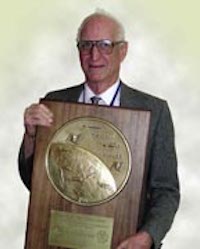Dr. Charles R. Cahn, an important early and continuing contributor to GPS signal and waveform design, passed away in January 2021. His accomplishments spanned a lifetime of contributions to GPS signal and receiver developments.
Cahn was a pioneer and a major contributor in the area of analysis and design of GPS signal structures and receivers. His work on the 621-B program, and during Phase-I of GPS was vital in defining the GPS signal structures. Subsequently, he made critical contributions to GPS modernization including analysis and design of key elements of the military GPS signal. He participated in M-code wave-form design as well as contributing to the design of the GPS L5 signal and the proposed design of the Replacement Code for the civilian GPS L2 signal. He was also instrumental in the development and analysis of a similar Time Division Data Multiplexing (TDDM) approach for the M-code signal, enabling benefits of a dataless signal component.
As chief scientist at Magnavox, he directed an early study that helped establish the GPS wave-form and participated in the design and development of GPS user equipments for military and civilian applications. He retired from the Magnavox APS Company as Vice President in 1990. For a period he was chief scientist at SiRF Technology and continued to provide services there as a consultant, then became chief technology officer at the WirelessHome Corporation while also working as a consultant to the Aerospace Corporation.
He received his B.E.E., M.E.E. and Ph.D. from Syracuse University in 1949, 1951 and 1955, respectively, was a fellow of the Institute of Electrical and Electronics Engineers and the Institute of Navigation.
He received ION’s 2004 Kepler Award in 2004 “For sustained and profound technical contributions, leadership, and analysis, from the early 1970’s through current modernization activities, which have shaped the most basic GPS signal structures, pioneered receiver signal processing techniques, and thereby substantially improved system performance for both military and civilian GPS users.”
In recounting the early history of GPS, Brad Parkinson recalled the most important early studies aimed at selecting the best passive ranging technique for the navigation signal. Experts including Dr. Fran Natali, Dr. Jim Spilker and Dr. Charles Cahn concluded that the best technique was a variation of a new communications modulation known as code division multiple access (CDMA). Cahn advocated a C/A code length of 2047 chips, while Spilker wanted 511. Parkinson split the difference, yielding the code length of 1023 that the world enjoys today.
A memorial will be held for Dr. Cahn on February 27, 2021.






